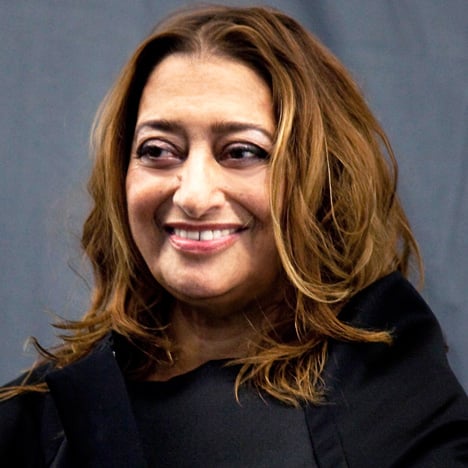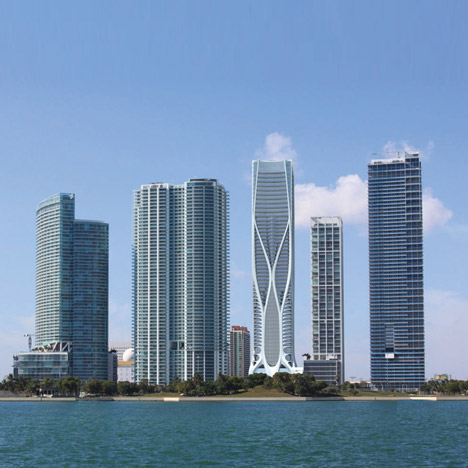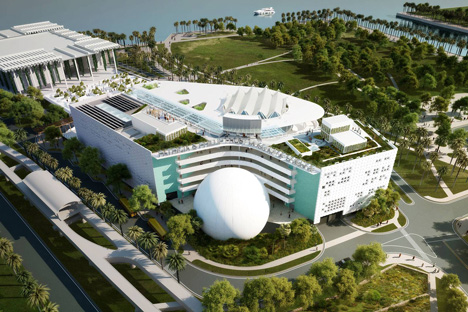
"They thought I was a troublemaker" says Zaha Hadid
Feature: Zaha Hadid was in a garrulous mood at a panel discussion in Miami earlier this month, discussing the lack of women in architecture, describing her "untraditional" education and recalling the stressful early days of her practice, when "there were years when I didn't sleep for four nights in a row".
The British architect also criticised Grimshaw Architects' Patricia and Phillip Frost Museum of Science – which is being built across the road from her One Thousand Museum residential tower in Miami.
"It really is a disappointing project," she said. "It doesn't look like a museum. I'm sorry, but it's really a letdown."

The panel discussion between Hadid, her firm's director Patrick Schumacher and selected journalists, took place after the groundbreaking ceremony for One Thousand Museum, a 60-storey condominium tower on Biscayne Boulevard in downtown Miami. "We're charging not very much," she joked of the project. "It's a present from me."
Speaking about her education at the Architectural Association school in London, the 64-year-old said: "They thought I was a troublemaker." But she also described the "delirious" period when her office worked furiously on early, seminal projects such as the Vitra Fire Station, which she describes as one of her favourites. "These were the years when I didn't sleep for four nights in a row, or weeks," she said. "It was a very exciting time."

Despite being the world's most famous female architect, she said: "I don't generally think of myself always as a woman architect, as I've said many times. I feel that I should be recognised as an architect first."
Hadid also hit back at Japanese architects who have criticised her design for the 2020 Olympic stadium in Tokyo, describing their comments as "embarrassing for them". "They don't want a foreigner to build in Tokyo for a national stadium," she said.
Read on for edited highlights of the discussion:
On her architectural education:
"They thought I was a troublemaker. The [Architectural Association] school of architecture was untraditional. The idea that you become a student and you find yourself in this situation when you are a first year student and you've never done architecture before. We were doing this presentation and nobody could make a model, nobody could make a drawing and I said: 'If you want us to do a good model [then] why don't you teach us how to do that? Because we don't know. We can't improvise.' I learned to improvise after that! But they were very good afterwards. Actually, it went from a very bad year to a very powerful year.
"I went to school in London at a time when everyone was obsessed with an idea. If you didn't have an idea, you were a monkey. You were obliterated from business. They trained us on how to build an idea and concept. That's always been my ambition. As long as the project has a central focus, then you can adjust things with it."
On women architects:
"There are lots of women in school and whenever I teach I have a lot of women students, all from the beginning. When I started teaching there were mostly boys, and now there are lots of women who are actually sometimes the best students in the studio. It's a mystery to me what happens to them afterwards. I don't know what happens, whether it's a lack of confidence or difficult circumstances in offices or vanity or they're not accepted. I don't know.
"I don't generally think of myself always as a woman architect, as I've said many times. People ask 'what is it like to be a woman architect?' and I say 'I don't know, I've not been a man'. I feel that I should be recognised as an architect first. But now I think that if it serves as an inspiration or it helps women architects to push on then that's fine. Whenever I give lectures, I get lots of women come up to me wanting reassurance that it's a trip worth taking."
On skyscrapers:
"I think it's very interesting. Cities are growing. More and more people want to go to the city. For example, I can talk about London. London had a policy to make everything very dense and very low in certain areas, but it really infringes on the street. You have thousands of people in these alleys and no outdoor spaces, there's no room to breathe. So I think in some cases you have to go up. And of course I think it is an interesting situation because you have a lookout, you have more units and you create a skyline.
"And I think America was very obsessed with this in the 1960s. When they started building, every city's ambition was to become a major city by forming a skyline. In Europe you have less towers, but in London now they're becoming tall and they are a bit random. There's no masterplan policy that says 'this area has a high-rise'; they pop-up wherever.
"In Beijing, they don't design one [skyscraper]; they build an ensemble, which is always three or four buildings. That's also interesting because you don't have everything popping up differently from the next neighbouring thing.
"In Europe [Skyscrapers] were always connected to corporate offices. That has changed because I think that now many more people want to be in a new-build, and they want to have a views and a concierge like in America.
On American architects:
"Americans are building a lot in Europe. SOM, KPF, [Raphael] Viñoly, they're building all the towers. We don't have anything there. They think of themselves as the masters of corporate architecture."
On the One Thousand Museum skyscraper:
"We're charging not very much. It's a present from me.
"We looked at the idea of structure. To develop ideas of form on their own was not really enough in terms of programming. So we looked at the idea of how the building could be designed in terms of structure. The structure we designed allows you certain things within the interior space, and how it's meeting the ground.
"In the original diagram, the structure is in three layers, then it divides into two - so then two apartments - and then it becomes one, so the structure also reflects what is on the interior of the layout of those apartments. And then on the top floor we have a double-height space and public space, and the swimming pool.
"It's not that much more difficult to build. I think the only things that are now difficult to build are the things that defy gravity and are floating around. In America there is usually a column grid and repeating the floors, and the idea was to really accentuate the entrance of the structure on the exterior - to make it part of the formulas, but it also operates as part of the structure."
On Grimshaw Architect's Patricia and Phillip Frost Museum of Science in Miami:
"Unfortunately it really is a disappointing project. It doesn't look like a museum. It looks like a museum that somebody built when they had no ideas 70 years ago. And I think Grimshaw should not do this. I'm sorry, but it's really a letdown. Completely. He's a very good architect but this is not his best moment. He's going to kill me when I get back to London, but I don't mind."
On criticism of her Tokyo stadium by prominent Japanese architects:
I think it's embarrassing for them, that's all I can say. Many of them were friends of mine, actually the ones which I supported before like Toyo Ito, who I worked with on a project in London. I've known him for a long time. I understand it's their town. But they're hypocrites. If they are against the idea of doing a stadium on that site, I don't think they should have entered the competition.
"The fact that they lost is their problem, they lost the competition. They don't want a foreigner to build in Tokyo for a national stadium. But on the other hand, they all have work abroad. Whether it's Sejima, Toyo Ito, or Maki or Isozaki or Kengo Kuma. It saddens me. What can I do? They're going ahead with it irrespective.
On being an outsider:
"I'm not part of a network, out playing golf or schmoozing on a boat with the fellow guys.
People think I only do cultural buildings and I don't. I like doing them, because the only way I could enter the field was by doing competitions for museums. We were lucky to win them, so we got forward on that. For me, that was a great reward to be entered in these competitions and sometimes win them, sometimes lose them. But they were mostly for public buildings. But we have done cancer research facilities, schools, ski jumps, pools. We're doing the stadiums in both Qatar and Japan, we do a lot of infrastructure, like bridges, railway stations. Not many towers.
On small projects:
"In our office, we're proud of the very small things we do. Could be a piece a jewellery, or cutlery. And they are easier things sometimes. The scale is very exciting for us, we're able to do every scale. Different projects I'm proud of in different ways. Some of the because of the charity, some of them because of the programme, some for the way we use them.
On her favourite projects:
"I have my personal favourites because they were seminal projects at the time they were done. Vitra Fire Station, the MAXXI Museum in Rome, these buildings were an incredible pain in the office. These were the years when I didn't sleep for four nights in a row, or weeks. It was a very exciting time. We got so delirious at the end of that period that interesting things began to emerge. We developed a lot in that period, we didn't necessarily use them but they became the background to the practice."
On her working relationship with Patrick Schumacher:
"I say no, he says yes. I am a constant critic in the office. We've worked together for 25 years so we have a system where we have similar thoughts on projects and how we should move forward. Although the kids [in the office] always go to him because he says yes to everything."